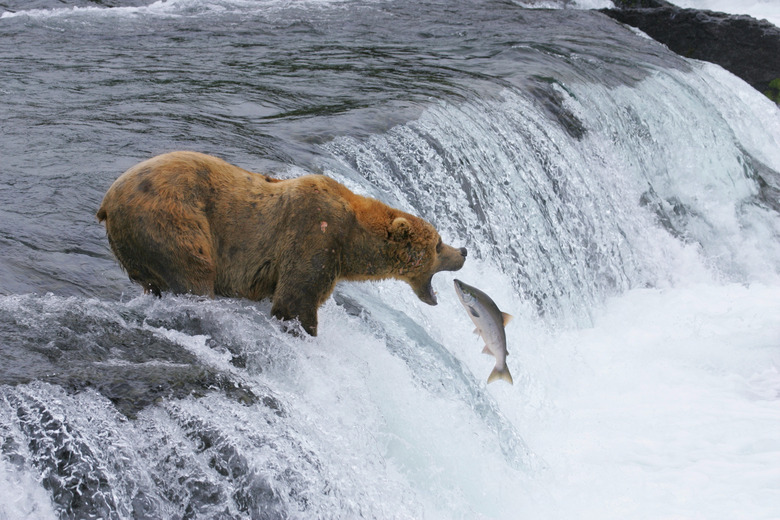Animals Of The Ecosystem
Ecosystems are made up of a variety of living organisms as well as nonliving factors such as water, sunlight and rock. Animals play essential roles in the formation and maintenance of the ecosystems they live in. For example, one ecological role of animals in their environment is to act as consumers, which is a vital part of the community dynamics and energy flows of the ecosystem.
Definition of an Ecosystem
Definition of an Ecosystem
An ecosystem consists of communities of plants, animals and other living organisms, their physical environment (which includes rocks, minerals, soils, sunlight, water, climate and other abiotic factors) and the interrelationships between them in a given area.
An ecosystem can be defined at many scales, depending on your perspective. Examples include communities of tiny invertebrates, microorganisms and algae living in a puddle and savanna grasslands where thousands of herbivores migrate hundreds of kilometers annually to follow the rains.
An ecosystem can be the size of a single tree, including the creatures and plants that live on it, or one particular mountain or lake. Alternatively, ecosystems can be as large as entire mountain ranges, chains of wetlands or vast forests that stretch across continents.
Producers
Producers
Two main components of an ecosystem are producers and consumers. Producers convert sunlight into energy through photosynthesis. Producers include plants, algae and many bacterial species. Almost all ecosystems on Earth rely on photosynthesis and the sun as their energy source.
However, there's one notable exception: deep-sea hydrothermal vents where no sunlight can reach. In these ecosystems, bacteria are the producers – they use chemicals in the water to create energy through the process of chemosynthesis. These bacteria are then consumed by mussels and worms, forming the base of a complex ecosystem that exists totally independent of sunlight.
Consumers
Consumers
Consumers subsist on organic matter derived from photosynthesis. This occurs in a variety of forms and at many different levels. Consumers include primary consumers, who eat plants and other producers directly, and secondary consumers, who consume other consumers. All animals, as well as some fungi, bacteria and plants, are consumers.
Primary consumers are usually classed as herbivores (plant-eating organisms), while secondary consumers are often carnivores (meat-eating organisms) or decomposers. However, individuals may act in several of these roles over the course of their life cycle. This is especially the case for omnivores, which consume both plants and animals.
Roles of Animals in Ecosystems
Roles of Animals in Ecosystems
Animals can play significant and pivotal roles within an ecosystem. Birds, insects and bats all perform pollination services, which are essential in many types of agriculture. Birds and mammals eat berries and then disperse seeds through their droppings. Herds of grazing animals stimulate new life by disturbing the ground and eating or breaking up old, mature vegetation.
Keystone Species
Keystone Species
All species have specific functions within an ecosystem, but some species have a disproportionately large effect. Animals that benefit the environment in this way are referred to as keystone species.
Keystone species are often predators, such as wolves and bears in North American forests, sharks in coral reefs and jaguars in tropical rainforests. Keystone species help shape the local ecology by influencing herbivore behavior. The presence of predators discourages herbivores from relaxing and eating whenever they desire. When predators are removed from an ecosystem, vegetation is often overgrazed, which then negatively affects habitat for other wildlife. This highlights an important role of animals in maintaining ecological balance.
Another example of a keystone species is the beaver, which is referred to as an "ecosystem engineer." By chewing down trees and using them to create dams across streams, beavers encourage open lakeside and grassland habitat by removing shade trees. This also creates ponds and channels in which aquatic animals and plants can grow.
Other ecosystem engineers include woodpeckers, which create tree hollows used by many different species, and gophers, which dig extensive networks of tunnels that other creatures such as foxes, snakes, owls and rodents also use for shelter.
Importance of Biodiversity
Importance of Biodiversity
An essential component of ecosystem health is complexity and biodiversity – the variety of living things within an ecosystem. Changes in habitat complexity or the loss of any individual species will have a negative effect on the overall ecosystem. Keystone species provide dramatic examples of the changes that can occur when ecosystems are disrupted, but any reduction in complexity and diversity will impact the resilience of the system.
Cite This Article
MLA
Michelle, Meg. "Animals Of The Ecosystem" sciencing.com, https://www.sciencing.com/animals-of-the-ecosystem-12213537/. 30 September 2021.
APA
Michelle, Meg. (2021, September 30). Animals Of The Ecosystem. sciencing.com. Retrieved from https://www.sciencing.com/animals-of-the-ecosystem-12213537/
Chicago
Michelle, Meg. Animals Of The Ecosystem last modified August 30, 2022. https://www.sciencing.com/animals-of-the-ecosystem-12213537/
